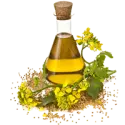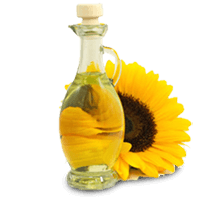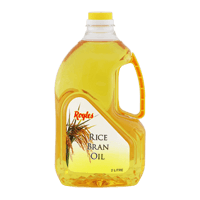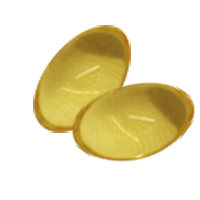Mustard oil nutrition: glycemic index, calories and diets

Introduction
Mustard oil is derived from the seeds of the mustard plant. The term can refer to both vegetable and essential oils; however, the two are produced through different methods and have separate qualities and uses.
Varieties
The mustard vegetable oil is produced by pressing the seeds, whereas to attain the mustard essential oil, the seeds have to be ground, merged with water, and later distilled by steaming.
Vegetable oil is usually used to cook satué or stir-fry vegetables. Mustard oils are cold-pressed and unrefined. On the other hand, essential oils are often used in traditional or alternative medicine to relieve stress as a massage oil, improve skin conditions as a skin serum, aid digestion, and in many more ways. However, essential oils could also be used for cooking.
Mustard oil is commonly used in Southeast Asian cultures, especially India, Bangladesh, and Pakistan. It has been banned for edible consumption in the USA, the UK, and Canada because it contains a compound called erucic acid, which is believed to have negative health impacts, such as nutritional deficiencies and cardiac lesions (1). However, research has not found compelling evidence to prove this.
The essential or volatile mustard oil is approved for use in food or as a flavoring.
Serving Size
The serving size of mustard oil is one tablespoon, equivalent to 14g.
Nutrition
Vegetable oils are fats extracted from the seed or the plant, so naturally, like other oils, mustard oil is monotonous in its nutritional composition.
Macronutrients and Calories
The macronutrient composition of mustard oil is pretty simple. Mustard oil contains no carbohydrates and no protein. It consists entirely of fats.
Mustard oil contains more fats than 99% of other foods. A 100g of mustard oil has 884 calories, responsible for 154% of your daily value of the average caloric intake. However, the serving size of this oil is only one tablespoon, equalling 14g.
Macronutrients chart
Fats
The most interesting thing about the nutrition of mustard oil is its fat composition.
Mustard oil is rich in monounsaturated fats, which comprise 64.3% of its nutrition. Polyunsaturated fatty acids are in second place with 21g, leaving saturated fats in the last place.
This oil also has no trans fats and contains no cholesterol as a plant-based product.
A fat molecule called allyl isothiocyanate gives the mustard oil its potent smell. This same compound gives mustard, horseradish, and wasabi their specific tastes and scents.
Fat type information
Vitamins
Mustard oil contains no vitamins except for vitamin E in the form of α-tocopherols (10).
Minerals
Mustard oil contains minerals in insignificant amounts.
Glycemic Index
Mustard oil contains no carbohydrates and has a glycemic index of 0.
Acidity
The acidity of mustard oil based on the Potential Renal Acid Load (PRAL) equals 0.
Health Impact
The health impact of mustard oil is an interesting topic because it is used in traditional medicine in one part of the world and banned for its supposed harmful effects in the other.
Allergy
Mustard allergies often manifest in people allergic to it right after consuming any product derived from mustard plants, such as mustard oil, mustard seeds, mustard or cress, and others.
The general symptoms follow the food allergy pattern with rashes, nausea, vomiting, and a feeling of itching, tingling, or swelling in the mouth as part of the oral allergy syndrome. More severe symptoms can include difficulty breathing, severe asthma, and anaphylaxis. Symptoms tend to occur between a few minutes and two hours after eating.
The major allergen found in mustard seeds is a heat-resistant protein also resistant to degradation by proteolytic enzymes. Therefore, processing and cooking the seeds do not eliminate the allergen (2).
According to European Union laws, mustard is one of the 14 major food allergens that has to be listed on a prepackaged product that contains it, even if it appears in small quantities. The reason for that is the prevalence of mustard allergies in some European countries, such as France and Spain. However, it appears to occur much more rarely in the UK (3). Mustard is also considered a priority food allergen by Health Canada (4).
People suffering from mustard allergies are much more likely to be sensitized to other allergens. Some researchers believe mustard sensitivity should be routinely tested in patients with idiopathic anaphylaxis (5).
Mustard allergens were proven to have cross-reactivity between mugwort pollen, one of the primary sources of hay fever and allergic asthma, nuts, legumes, corn, and fruits of the Rosaceae family, including apples, pears, peaches, apricots, cherries, and some berries (6).
The mustard plant belongs to the Brassicaceae family, including cabbages, broccoli, cauliflower, Brussels sprouts, and canola. People with mustard allergies should be wary of those foods since they can contain very similar proteins to mustard seeds.
Canola oils tend to be refined to the point of containing almost no proteins, so highly refined canola oil poses no threat to people with a mustard allergy. However, being less refined, cold-pressed canola oil can contain residual protein and should be avoided. Rapeseed oil can also be cold-pressed and pose a health risk (7).
Mustard allergy is diagnosed by a skin prick test or through antibodies in a blood test. People with a mustard allergy are advised always to carry an epinephrine auto-injector if they are going to eat anything.
Diabetes
A study about the effects of edible oils on type 2 diabetes mellitus concluded that mustard oil was second in place based on its benefits after sesame oil.
Mustard oil increases the levels of high-density lipoprotein, which is called the “good” cholesterol. It absorbs cholesterol and carries it back to the liver to be removed from the body later. It was not found to significantly decrease low-density lipoprotein, known as “bad” cholesterol. Mustard oil also had some effects in decreasing very low-density lipoprotein (8).
Traditional cooking oils, such as mustard, could reduce the risk of dyslipidemia, atherosclerotic heart disease, and type 2 diabetes mellitus. Mustard oil is said to enhance the activity of pancreatic beta cells and increase insulin secretion. It also contains elaidic acid and vitamin E, which are protective in diabetic conditions (9).
Some research has indicated that trans fats significantly cause insulin failure and high-fat oxidation. The absence of trans fats in mustard oil can benefit insulin control in the body (10).
Cancer
Mustard oil contains phytonutrients such as glucosinolate, which has antibiotic, fungicidal, and anticarcinogenic effects. This phytonutrient is also said to protect against colorectal and gastrointestinal cancers (10).
Glucosinolates are also called mustard oil glycosides, from which mustard oils are enzymatically hydrolyzed. It has potent antioxidant qualities, which protect the cell DNA from damage; therefore, it inhibits mutations and potential oncogenesis. In particular, a glycoside called sulforaphane, which can also be found in high amounts in other plants of the Brassicaceae family, broccoli and its sprouts, has been studied to target most cancer stem cells, which are typically not affected by conventional cancer treatments (11).
Mustard oil can also effectively protect against and prevent colon cancer due to its high concentration of omega-3 and omega-6 polyunsaturated fatty acids (12).
Another compound that mustard oil is rich in is allyl isothiocyanate organosulfur. It has expressed various anticancer qualities in culture cancer cell lines and animal tumor models. It has also inhibited the growth of various human cancer cell lines, such as colorectal carcinoma, lung cancer, leukemia, breast adenocarcinoma, bladder cancer, neuroblastoma, hepatoma, and prostate cancer cells. These effects probably involve mechanisms like DNA damage, cell cycle arrest, and apoptosis. Allyl isothiocyanate can potentially be used in cancer treatment (13).
However, one study found that consuming high mustard oil can increase the risk of gallbladder cancer. Therefore, reduced consumption of mustard oil might have a preventative effect on gallbladder cancer (14).
Cardiovascular
One research has concluded that using mustard oil instead of sunflower oil when frying can decrease the risk of developing ischemic heart disease due to the concentration of α-linoleic acid in mustard oil. α-Linoleic acid reduces blood platelets' adhesion and aggregation qualities, decreasing the risk of thrombosis and myocardial infarction (15).
Mustard oil can also be one of the healthiest choices among edible oils due to its favorable linoleic acid to α-linoleic acid ratio, low saturated fat, and high monounsaturated fat content, along with its relative stability during cooking. Epidemiologic studies among Indians suggest that consumption of mustard oil can reduce the risk of coronary heart disease (16).
However, another study showed a positive correlation between coronary heart disease and increased consumption of mustard oil. This may be due to the high oleic and erucic acid content. The study suggests that the total consumption of mustard oil per month should be less than 1.75-2.06L (17).
In the kitchen, ghee, an Indian clarified butter, may be favorable over mustard oil for the blood lipid profile (18).
A randomized, placebo-controlled trial compared mustard and fish oil to placebo treatment in individuals with suspected acute myocardial infarction. After one year, the mustard and fish oils groups expressed significantly fewer total cardiac events. The mustard and fish oil groups also showed significantly reduced nonfatal infarctions, total cardiac arrhythmias, left ventricular enlargement, and angina pectoris. These effects may be due to the high content of omega-3 fatty acids and reduced oxidative stress (19).
One study found that mustard oil alone produced ambivalent results in blood lipid levels. However, a mixture of mustard and sunflower oil showed a favorable result, decreasing the levels of total cholesterol, low-density cholesterol, very low-density cholesterol, and increasing high-density cholesterols levels (20).
Mustard oil has also been suggested to have digestion-stimulating, antibacterial, antifungal, antiviral, antiallergic, anti-inflammatory, pain-relieving, and other effects (10), as well as the ability to reduce body temperature, protect from eye and throat irritation, protect children from asthma, allergic cold and asthmatic eczema (21).
Arthritis
There are several studies that show the effectiveness of mustard oil massages on people with arthritis. Warm mustard oil may reduce the joint pain (37). High omega-3 fatty acid content lowers the stiffness and symptoms of arthritis other than pain.
Erucic Acid Concerns
Mustard oil is banned in several countries, the USA, the UK, and Canada, due to its high concentration of erucic acid. Nevertheless, the negative impact of erucic acid on human health has not been proven yet.
Erucic acid is a long-chain monounsaturated fatty acid. It constitutes around 30-60% of the total fatty acids of a mustard seed (22).
Early reports have shown that erucic acid causes transient myocardial lipolysis in rats, characterized by accumulation of fat droplets in myocardial fibers, followed by focal myocardial necrosis and fibrosis (23). However, there’s a possibility that rats are not an appropriate model for these studies since they are potentially incapable of physiologically metabolizing such high concentrations of oil. There is also some evidence that rats' fatty acid metabolism differs from the metabolism of pigs and primates, making rats much more susceptible to myocardial lipidosis (22).
The erucic acid content in mustard oil may counterbalance the positive effect of linoleic acid on cardiovascular health by increasing the levels of triglycerides and low-density cholesterols. However, other studies suggest that the overall effect of mustard oil on cardiovascular health is beneficial (15).
The oil of rapeseed, another flowering member of the mustard family, also contains very high levels of erucic acid. However, the rapeseed grown in India has a higher erucic acid content than rapeseed grown in Europe and North America (24).
The available studies indicate that the accumulation of erucic acid can be found in the myocardium of individuals consuming significant amounts of mustard and rapeseed oil. However, it has not been associated with any observed human heart damage. The available evidence does not indicate a relation between myocardial lesions or significant myocardial lipidosis and consuming foods high in erucic acid (22).
Cooking
Mustard oil has a high smoke point of 480°F (250°C). Because of this, it is considered a good cooking oil. Mustard oil can also be used as flavoring.
Storing, Keeping & Conservation
It is best to store mustard oil in the refrigerator; otherwise, it will go rancid (25). Mustard oil should not be exposed to heat and light. It should be kept in the refrigerator for six months to a year (26).
Mustard oil blends can be kept for up to 12 months in the correct conditions and stored at room temperature (27).
Mustard Oil in Diets
| Keto | Mustard oil can be a good choice for edible oil in a keto diet since it entirely consists of fats and contains no carbohydrates (28). |
| DASH | Although mustard oil contains no minerals, including sodium, no trans fats, and no cholesterol, studies about mustard oil and cardiovascular health can be contradictory. However, The American Journal of Clinical Nutrition has found a negative correlation between mustard oil use and ischemic heart disease (15). The DASH diet recommends vegetable oils over other oils (29). This can include mustard oil. |
| Atkins | Consuming fat is an essential part of the Atkins diet. You can have 3 tablespoons of pure vegetable oil daily (30). That is equal to 3 serving sizes of mustard oil. |
| Mediterranean | Olive oil in a Mediterranean diet is much more common; however, you can increase your monounsaturated fatty acids intake by adding mustard oil to your diet (31). |
| Paleo | Vegetable oils, including mustard oil, suit the paleo diet. |
| Vegan/ Vegetarian/ Pescatarian | Mustard oil is derived from mustard plants and can be included in these diets. |
| Dukan | A big part of the Dukan diet is lowering your fat intake, so you cannot use mustard or any other oil freely at any point in this diet. In the Attack phase, you can only use a couple of drops for frying. Starting from the Cruise phase, you can use only one teaspoon of mustard oil daily (32). |
| Intermittent Fasting | You can use mustard oil during eating periods but not during fasting. |
| Low Fat & Low Calorie | Mustard oil consists entirely of fats, and one tablespoon contains 125 calories. It is better to avoid mustard oil, like most oils, in a low-fat and low-calorie diet. |
| Low Carb | Mustard oil contains no carbohydrates. It fits this diet. |
| Anti Inflammatory | The essential oil of mustard has been traditionally used as a pain reliever and an anti-inflammatory agent. Omega-3 fatty acids, as well as allyl isothiocyanate, which mustard oil is rich in, have been studied to have anti-inflammatory effects (33, 34). However, there is not enough research to say whether mustard oil can be useful in an anti-inflammatory diet. |
| BRAT | You can include moderate amounts of vegetable oil in a BRAT diet; however, fried food and raw vegetables should be avoided (35). |
Consumption and Production
Consumption of mustard oil has grown about 5 percent per year for the past 40 years and currently stands at approximately 2.3 million metric tons of production annually (36).
The use of mustard oil in cooking is banned in the USA, the UK, and Canada, and it can only be used for external use or as a flavoring agent.
Consumption and production of mustard oil occur daily in Southeast Asian countries, especially India, Bangladesh, and Pakistan.
Mustard oil is India's third most consumed oil, after palm and soybean oil (36).
References
- https://www.accessdata.fda.gov/cms_ia/importalert_89.html
- http://europepmc.org/article/med/2321809
- https://www.anaphylaxis.org.uk/wp-content/uploads/2019/07/Mustard-2016.pdf
- https://foodallergycanada.ca/allergies/mustard/
- https://www.researchgate.net/publication/11189963
- https://pubmed.ncbi.nlm.nih.gov/15575930/
- https://www.canada.ca/en/health-canada/services/food-nutrition/reports-publications/food-safety/mustard-priority-food-allergen.html
- https://www.researchgate.net/publication/259639550
- https://www.ijhsr.org/IJHSR_Vol.9_Issue.12_Dec2019/28.pdf
- https://www.researchgate.net/publication/336118318
- https://pubmed.ncbi.nlm.nih.gov/23224634/
- https://pubmed.ncbi.nlm.nih.gov/12860286/
- https://www.nature.com/articles/s41598-018-19353-7#Sec22
- https://onlinelibrary.wiley.com/doi/abs/10.1002/ijc.32952
- https://academic.oup.com/ajcn/article/79/4/582/4690142
- https://www.ncbi.nlm.nih.gov/pmc/articles/PMC4990724/
- https://www.ncbi.nlm.nih.gov/pmc/articles/PMC5121705/
- https://www.degruyter.com/view/journals/jcim/15/3/article-20170101.xml
- https://pubmed.ncbi.nlm.nih.gov/9310278/
- https://www.ncbi.nlm.nih.gov/pmc/articles/PMC2994567/
- https://www.arccjournals.com/journal/asian-journal-of-dairy-and-food-research/DR-1443
- https://www.foodstandards.gov.au/publications/documents/Erucic%20acid%20monograph.pdf
- https://www.ncbi.nlm.nih.gov/pmc/articles/PMC1277456/
- https://onlinelibrary.wiley.com/doi/abs/10.1002/lipi.19950970720
- https://themustardspecialist.wordpress.com/tag/store-mustard-oil/
- https://www.consumer-voice.org/food/increasing-the-shelf-life-of-mustard-oil/
- https://link.springer.com/article/10.1007/s13197-011-0540-8
- https://www.ketofy.in/is-mustard-oil-keto-friendly/
- https://www.nhlbi.nih.gov/health-topics/dash-eating-plan
- https://www.atkins.com/how-it-works/library/articles/the-rules-of-induction
- https://www.livemint.com/Leisure/ZXETv6rJUx0Nhuyu3roKJK/The-Mediterranean-diet-adapted.html
- https://mydukandiet.com/dieting/faq/can-i-use-oil-on-the-dukan-diet.html
- https://pubmed.ncbi.nlm.nih.gov/28900017/
- https://onlinelibrary.wiley.com/doi/full/10.1111/j.1582-4934.2011.01367.x
- https://www.mygidocs.com/content/uploads/2016/02/LOW_RESIDUE_DIET.pdf
- http://journals.plos.org/plosone/article/file?type=supplementary&id=info:doi/10.1371/journal.pone.0012046.s001
- https://ijneronline.com/AbstractView.aspx?PID=2014-2-4-18
Top nutrition facts for Mustard oil

| Calories ⓘ Calories for selected serving | 884 kcal |
|
Glycemic index ⓘ
Source: The food is assumed to have 0 or no glycemic index bason on the fact that it has no carbs and that foods with 0 carbs have no glycemic index
Check out our Glycemic index chart page for the full list.
|
0 (low) |
| Net Carbs ⓘ Net Carbs = Total Carbohydrates – Fiber – Sugar Alcohols | 0 grams |
| Default serving size ⓘ Serving sizes are mostly taken from FDA's Reference Amounts Customarily Consumed (RACCs) | 1 tbsp (14 grams) |
| Acidity (Based on PRAL) ⓘ PRAL (Potential renal acid load) is calculated using a formula. On the PRAL scale the higher the positive value, the more is the acidifying effect on the body. The lower the negative value, the higher the alkalinity of the food. 0 is neutral. | 0 (neutral) |
Mustard oil calories (kcal)
| Calories for different serving sizes of mustard oil | Calories | Weight |
|---|---|---|
| Calories in 100 grams | 884 | |
| Calories in 1 tsp | 40 | 4.5 g |
| Calories in 1 tbsp | 124 | 14 g |
| Calories in 1 cup | 1927 | 218 g |
Mustard oil Glycemic index (GI)
All nutrients for Mustard oil per 100g
| Nutrient | Value | DV% | In TOP % of foods | Comparison |
| Vitamin A | 0µg | 0% | 100% | |
| Calories | 884kcal | 44% | 1% |
18.8 times more than Orange
|
| Protein | 0g | 0% | 100% |
N/A
|
| Fats | 100g | 154% | 1% |
3 times more than Cheese
|
| Vitamin C | 0mg | 0% | 100% |
N/A
|
| Net carbs | 0g | N/A | 75% |
N/A
|
| Carbs | 0g | 0% | 100% |
N/A
|
| Magnesium | 0mg | 0% | 100% |
N/A
|
| Calcium | 0mg | 0% | 100% |
N/A
|
| Potassium | 0mg | 0% | 100% |
N/A
|
| Iron | 0mg | 0% | 100% |
N/A
|
| Fiber | 0g | 0% | 100% |
N/A
|
| Copper | 0mg | 0% | 100% |
N/A
|
| Zinc | 0mg | 0% | 100% |
N/A
|
| Phosphorus | 0mg | 0% | 100% |
N/A
|
| Sodium | 0mg | 0% | 100% |
N/A
|
| Manganese | 0mg | 0% | 100% | |
| Selenium | 0µg | 0% | 100% | |
| Vitamin B1 | 0mg | 0% | 100% |
N/A
|
| Vitamin B2 | 0mg | 0% | 100% |
N/A
|
| Vitamin B3 | 0mg | 0% | 100% |
N/A
|
| Vitamin B5 | 0mg | 0% | 100% |
N/A
|
| Vitamin B6 | 0mg | 0% | 100% |
N/A
|
| Vitamin B12 | 0µg | 0% | 100% |
N/A
|
| Folate | 0µg | 0% | 100% |
N/A
|
| Saturated fat | 12g | 58% | 10% |
2 times more than Beef broiled
|
| Monounsaturated fat | 59g | N/A | 8% |
6 times more than Avocado
|
| Polyunsaturated fat | 21g | N/A | 9% |
2.2 times less than Walnut
|
Check out similar food or compare with current
NUTRITION FACTS LABEL
Serving Size ______________
Health checks
Mustard oil nutrition infographic

References
All the values for which the sources are not specified explicitly are taken from FDA’s Food Central. The exact link to the food presented on this page can be found below.



